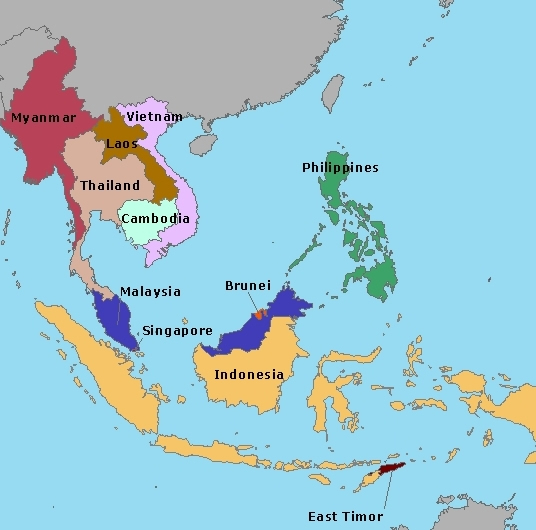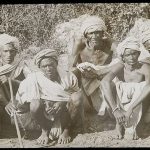Table of Contents
Introduction
• Southeast Asia is a large area of Asia that is east of India and south of China.
It has two different parts: a piece of land that sticks out from the continent (called “mainland Southeast Asia”) and a string of islands south and east of the mainland (called “insular Southeast Asia”).
• During the 1800s, Britain, France, and the Netherlands set up colonies in Southeast Asia.
• In 1799, parts of the Indonesian islands are taken over by the Dutch government from the Dutch East India Company. Over the next 100 years, it takes over the whole islands, including Sumatra and Bali. At this time, the current borders of Indonesia are set up.
• Beginning in 1824, Britain fights to take control of Burma. In 1886, it finally adds Burma to its Indian empire. It slowly takes over peninsular Malaya, and by 1874, the area that will become modern-day Malaysia is pretty much under its control. Thailand stays free and has a strong monarchy because the national government has more power over local chiefs and trade with Europe is open. But in 1887, France colonises Vietnam, Laos, and Cambodia and calls the new country the French Indochina Union.
• Colonisation has a huge effect on the region’s people and economy. The British give trained jobs to Indian and Chinese immigrants instead of Malaysians, who they think of as peasants. Education programmes deepen ethnic divides.
• In Cambodia, the French favour the Vietnamese over the local people, while the British encourage large numbers of Indians and Chinese to move to Burma. This strategy causes political divisions that are still felt today. The Burmese economy, which has been built on small-scale farming for a long time, is making a big change and becoming a big export economy. In Indonesia, a strategy called “Cultuurstelsel” forces farmers to grow crops that can be sold abroad. Even though the strategy is successful in some ways, it leads to famine and poverty. In Indonesia, traditional crafts like making batik and ikat textiles are being lost because people want to sell European goods in colonial stores. Regular wars that are fought to gain power hurt the area even more.

European colonisation of Southeast Asia
• During the 16th and 17th centuries, Europe began to settle Southeast Asia for the first time. There was a lot of competition among the new European powers to get a hold on the spice trade, which was very valuable to them because of the high demand for spices like pepper, cinnamon, nutmeg, and cloves. Because of this need, marine spice dealers from Portugal, Spain, the Netherlands, and later France and Britain came to the area.
• The Europeans were very competitive, so they quickly tried to get rid of each other by taking over production centres, trade hubs, and important strategic places by force, starting with the Portuguese taking over Malacca in 1511.
• The focus of conquests in the 17th and 18th centuries was on ports along the sea paths, which made it safe for ships to trade. It also gave foreign masters the power to tax and control the prices of goods that were very popular in Southeast Asia.
• By the end of the 19th century, all of Southeast Asia was under the control of different European countries, except for Siam, which was a buffer state between British Burma and French Indochina. After the Franco-Siamese War in 1893 and the Anglo-Siamese Treaty in 1909, the kings of Siam had to deal with repeated humiliations, accept unfair treaties, and lose land.
• The Industrial Revolution and the rise of strong nation states in Europe are linked to the second part of European colonisation of Southeast Asia. As the main goal of the first phase was to get richer, the reasons for and level of European interference in the second phase were based on geostrategic rivalries, the need to defend and grow spheres of interest, competition for commercial outlets, long-term control of resources, and the fact that Southeast Asian economies were becoming more tied to European industrial and financial affairs by the late 19th century.
The beginning
• From the 15th to the 17th centuries, Europe made progress in science, cartography, shipbuilding, and navigation. At the same time, the Turks tightened their control over the Eastern Mediterranean gateways to Asia, which led the Portuguese, Spanish, and Dutch to sail around Africa in search of new trade routes and business opportunities.
• Niccol de’ Conti was the first European known to have visited Southeast Asia. He did this at the beginning of the 15th century. By 1498, Vasco da Gama had found the first straight sea route from Europe to India. He did this by sailing around the Cape of Good Hope.
• Pepper, cloves, nutmeg, mace, and cinnamon, which were grown in Southeast Asia and sold for a lot of money, were some of the most valuable spices that were planned to be traded directly and permanently. To get exclusive access to the centres of production, each country had to fight hard and use violence against the others.
• In the 17th century, the Dutch and the Spanish took control of it from the Portuguese. In the 18th century, the British took over Southeast Asia from the Dutch. This was because the British were interested in India, which was in Southeast Asia.
• When Portugal took over the Sultanate of Malacca in 1511, it was the first time a European country set up a foothold in maritime Southeast Asia.
• After Portugal, the Netherlands and Spain took over as the most important European countries in the area. The Philippines were first settled by Spain in 1599. Through the Dutch East India Company, the Dutch took over the city of Sunda Kelapa in 1619. They changed its name to Batavia, which is now known as Jakarta, and used it as a centre for trading and expanding into other parts of Java and the area around it. Malacca was taken from the Portuguese by the Dutch in 1641.
• Many Overseas Chinese moved to the area because it was a good place to do business. In 1775, the Lanfang Republic was set up in West Kalimantan, which is now in Indonesia. It was a client state of the Qing Empire and may have been the first republic in the area. The republic lasted until 1884, when it was taken over by the Dutch as the Qing Empire lost power.
The industrialised era
• At first, the British East India Company, led by Josiah Child, didn’t care much about the area and didn’t have much of an effect on it. After the Siam–England war (1687), they were basically kicked out. After the Peace with France and Spain in 1783, Britain, under the name of the British East India Company, turned its attention to the Bay of Bengal.
• During the wars, Britain and France fought over who had the best navy, and it became clear that they needed good harbours. Francis Light brought Penang Island to the attention of the Government of India. In 1786, Captain Francis Light started the town of George Town on the northeastern tip of Penang Island, with Sir John Macpherson in charge. This was the first step in the British taking over the Malay Peninsula.
• By the end of the 18th century, Europe was feeling the full effects of the Industrial Revolution. Rapid advances in science, industry, and technology had made the rest of the world, including Southeast Asia, much weaker than Europe. If tools were used a lot to make things, on the one hand, Europe would need more raw materials and on the other, it would have too many things. By the 19th century, the economies of Europe and Southeast Asia were very dependent on each other. Southeast Asia was a major source of materials and supplies for European economies. To keep up with the amount of extra goods being made, European manufacturers pushed for the opening of new markets in places like Southeast Asia. This led to the next step in building imperial rule. European leaders changed the way politics worked in the colonies so that the monopoly markets could grow even stronger.
• However, industrialization happened at a time when the European powers were competing more and more with each other. Changes in the balance of power on the continent made this more likely to happen. France lost its power because of the Napoleonic Wars. Britain’s economic and naval power, which was once unmatched, began to weaken over time. Because of the competition between European countries, the world was split up into spheres of influence. There was also a need to fill “vacuums” of territory that would have been ruled by a rival European power otherwise.
During the Napoleonic Wars and the Seven Years’ War, the British briefly controlled parts of the Netherlands and Spain. In 1819, Stamford Raffles set up Singapore as a key trade post for Britain, which was competing with the Dutch at the time. But when an Anglo-Dutch treaty in 1824 set out each country’s interests in Southeast Asia, the competition between them died down. The first Anglo-Burmese War (1824–1826) was the start of British rule in Burma.
• This trend, called “New Imperialism,” led to the colonial forces taking over almost all of Southeast Asia. The Dutch East India Company and the British East India Company were broken up by the governments of each country, which then took over direct control of the colonies. Only Siam was able to avoid direct foreign rule, but it had to change its government and make a lot of compromises to make the Western powers happy.
• The Monthon reforms, which started in the late 1800s and went on until around 1910, gave the country’s partially independent towns called Mueang a Western-style form of government. This means that the country could be said to have successfully colonised itself. Still, Western powers kept meddling in both internal and external matters.
• By 1913, the British crown controlled Burma, Malaya, and the northern part of Borneo. The French ruled Indochina, the Dutch ruled the Netherlands East Indies, and Portugal held on to Portuguese Timor.
• The 1872 Cavite Mutiny in the Philippines was the start of the Philippine Revolution in 1896 and 1898. When the Spanish–American War started in Cuba in 1898, Filipino revolutionaries proclaimed freedom for their country and set up the First Philippine Republic the next year. The United States got the Philippines and other land from Spain in the Treaty of Paris of 1898, which ended the war with Spain. The self-proclaimed republic wasn’t accepted by any other country. During the Philippine–American War, Washington sent in the army to take control of the islands. The war finished when the rebel leaders were caught.
After that, there were fights with the self-proclaimed Republics of Zamboanga, Negros, and Katagalugan, all of which were also destroyed.
• Around the middle of the 19th century, Europeans had certain goals that they thought were important for people. One of these goals was summed up in the slogan “The White Man’s Burden,” which was the purpose to “civilise” (improve) the “less fortunate” and “less talented” people of Southeast Asia. In order to do this, they put in place policies that gave people access to schooling and health care. Christian missionaries were often in charge of schooling, health care, and fighting against the slave trade.
• Buying colonies wasn’t always a sign of power. Sometimes, it was a way to regain lost status. France was too busy trying to grow its colonial power to deal with the shame of losing the Franco-Prussian War of 1870. It went into Indochina because it wanted to improve the image of the government at home and keep up with other important European powers in terms of colonial gains.
Role of the Europeans
• In the beginning, most of Europe’s power in Southeast Asia consisted of setting up trading posts. These trading posts were used to store Asian goods that were bought from local merchants before they were sent to Europe.
• These trading posts had to be set up along major shipping routes, and the local ruler had to give his or her permission for them to open. Only then could trade take place in peace. Early trade posts included Malacca, Penang, Batavia, and Singapore.
• During the industrialised phase, however, the Europeans’ role changed because they were able to control more than just their trade posts. Because there was more trade, the number of trading posts grew, and so did the demand for food and wood to build and fix ships. To make sure they had a steady source of food and wood, the Europeans had to work with the nearby people. This was the start of taking control of land.
The case of Batavia shows this well. There, the Dutch took over parts of western Java and, later, parts of central and eastern Java, where rice was grown and wood was found.
• The Europeans had to keep their government stable so that trade could grow. They sometimes got involved in the lives of the people to keep the peace. The Europeans also tried to bring their own culture to the countries they controlled.
Impact
• European influence has changed everything about life in Southeast Asia. Europe made rapid advances in science and technology and brought new government and educational systems to the region. At the same time, it took advantage of the region’s economy, stole a lot of its resources, and treated people of different races and ethnicities badly.
• People in the Southeast Asian countries had very different ideas about how politics really worked. At the beginning of the 20th century, the leaders of Vietnam’s communist movement were very hopeful. They “predicted a blessed future in which cars and trains would no longer be uniquely Western,” while the Dutch author J.H. Boeke said, “Societies like Indonesia will always be two-sided.”
• The need for more workers led to a lot of people coming from British India and China, which caused a huge change in the population. The study of institutions for a modern democratic nation state with a state bureaucracy, courts of law, print media, and modern education helped start nationalist and freedom movements among the colonial subjects. During the time between the two world wars, these nationalist groups grew, and when they asked for the right to decide for themselves, they often clashed with the colonial authorities.
• The growth of European power through colonialism was seen as special because it had a big impact on all of Southeast Asia. Later, there were more things in common, like the rise of nationalist groups, the Japanese occupation of Southeast Asia, and the Cold War, which affected a lot of the area. When you look at the history of the area as a whole, you can say that there was a common core. This core defined the area, which is why the word “Southeast Asia” can be used to talk about it as a single thing.
• Because of colonialism, which brought modern western ideas to Southeast Asia, the social system has changed. Some of these ideas, like human rights, religion, and education, came from western society.
• Because European forces are there, the number of people living in the area has grown. First of all, the area’s economy was growing quickly during the colonial time. Populations were growing back then so that there would be enough workers to make things like raw materials and industry plants.
• In the meantime, immigration changed some of the countries in the area. For example, Chinese people moved to Malaysia because of how bad things were in China and how well the economy was doing there. The British also hired workers from India. Then, when a lot of Chinese and Indian people moved to the Malay Peninsula, Malaysia changed into a mixed state.









![Ancient Indian History Notes for UPSC [All Parts] IMG_20210719_185812](https://iasbio.com/wp-content/uploads/2021/07/IMG_20210719_185812.png)






